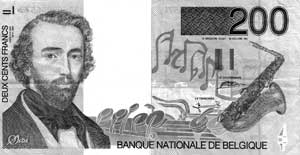
Adolphe
Sax & the Saxophone
by Mr.
Rodney J.Croft
Adolphe
Sax, born in November 1814 in Dinant
on the river Meuse in Belgium, became
a prolific inventor whose inventions
included the saxophone, patented in Paris
in 1846. It is one of the most instantly
recognizable of all musical instruments
and has for many years been inextricably
linked to the jazz genre. The history
of Sax and the origin of his invention
provide an interesting story.
Adolphe's
father, Charles Sax, at the age of fifteen,
became an apprentice cabinetmaker in
Brussels, and at this time he played
a serpent (a now obsolete large wooden
S-shaped bass wind instrument) in a local
musical society. A serpent was an expensive
instrument so Charles Sax made his own;
a skill he would return to.
The
advent of the machine age brought about
a surge in the Belgian textile industry
and Charles Sax took a job in a factory
making cotton-spinning machines. Following
Wellington's defeat of Napoleon at the
Battle of Waterloo in 1815 the Belgian
economy and the textile industry slumped,
leading to the closure of factories and
the loss of Charles Sax's job.
Charles Sax then returned to his previously honed skills and began to
make musical instruments including
serpents, flutes, and subsequently
bassoons, clarinets and brass instruments.
He even began making string instruments
including pianos, violins, harps and
guitars.
His
son Adolphe therefore grew and developed
in this environment of musical instrument
manufacture. He began to be increasingly
involved in his father's business and
developed both as a craftsman and as
a player of the flute and clarinet. He
attended the Royal School of Singing
in Brussels where he developed his playing
abilities to a very high proficiency,
particularly on the clarinet.
There
are various theories as to why and how
the saxophone originated. One belief
is that Sax discerned a tonal gap in
the Symphony Orchestra between the cellos
and the brass section. It is possible
to appreciate the success of bridging
this gap when hearing the tenor saxophone
solo line in Ravel's Bolero. Or perhaps
it was Sax's efforts to find a bridge
between the woodwind and bridge in a
Military band. Another theory surrounds
a search for a brass instrument with
stronger volume dynamics than the wooden
clarinet family. Whichever of all the
theories is correct one thing seems certain;
Sax was searching for a previously undiscovered
sound either in timbre and or volume
dynamics. No doubt he experimented with
a number of different ideas but it is
thought he finally combined an ophicleide
(a euphonium-like sounding instrument)
with a bass clarinet mouthpiece. The
ophicleide, from the Greek "serpent and
key," was invented in 1817. It superseded
the serpent, and Sax had access to ophicleides
in his father's workshop. The ophicleide
was basically a bass keyed bugle and
was a conical brass instrument with the
brass cupped mouthpiece and replaced
it with the single reed mouthpiece of
a bass clarinet thereby creating a conical
bore brass instrument with a single reed.
The saxophone was born!
The
first saxophone was a bass and subsequent
models followed-eight models were patented
in 1846. Now the following are available:
sopranino and soprano (both usually straight
but can also be curved), alto, tenor,
baritone and bass. In 1857 Sax was appointed
instructor of the saxophone at the Paris
Conservatory.
Sax
also made major changes to the keys and
articulation of the bass clarinet much
of which lasts to this day. He also manufactured
brass instruments including the Saxhorn
for Military bands and won large contracts
for French Army Regiments. He was so
successful, a number of attempts were
made by rivals to spike his instruments
prior to crucial military band competitions
in the Tuilerie Gardens in Paris, and
there were also assassination attempts,
which gladly he escaped. However, he
suffered multiple lawsuits from rivals
who tried to steal his patents and towards
the end of his life was in abject poverty.
Chabrier, Massenet and Saint-Saens petitioned
the Fine Arts Minister to come to his
aid. He died in Paris in February 1894.
Adolphe
Sax will always be remembered for his
wonderful invention-the Saxophone. So,
but for the Battle of Waterloo-where
would Jazz be?#
Rodney
Croft is a Consultant General and Vascular
Surgeon in London, England. He is also
a professional saxophonist.
